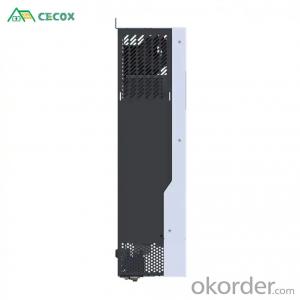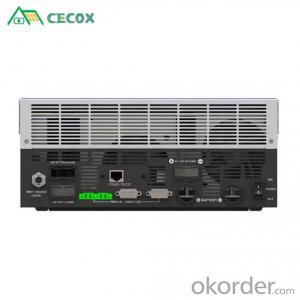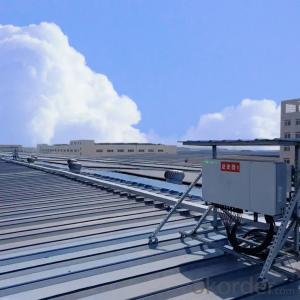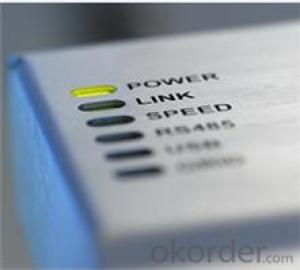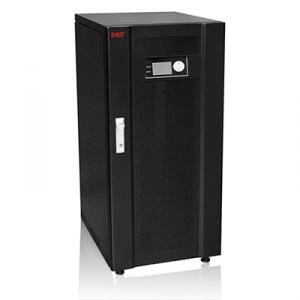Solar Inverter Battery Charger - 5.5kW Off-Grid Hybrid Solar Home Inverter with MPPT Charge Controller
- Loading Port:
- China main port
- Payment Terms:
- TT OR LC
- Min Order Qty:
- 1 unit
- Supply Capability:
- 10000 unit/month
OKorder Service Pledge
OKorder Financial Service
You Might Also Like
Specification
Advantages
110A PV MPPT input
Wide PV input voltage range
Overload/overtemperature/short circuit protection
Smart battery charger design to optimize battery performance
Support mains/generator input
Adaptive lithium battery
Support maximum parallel machine (P model)
Multiple charging voltages, suitable for different batteries
Multiple working modes: mains priority, PV priority
Key Parameters
Output Type:Single, Pure Sine Wave
Type:DC/AC Inverters
Inverter Efficiency:94%
Place of Origin:China
Model Number:XN5548, XN5548-P
Input Voltage:48V DC
Output Voltage:230V AC ± 5%
Output Current:23A
Output Frequency:50Hz/60Hz
Size:472W*297H*133D mm
Certificate:CE/IEC/ISO/TUV
Warranty:5 years
Weight:10.5kg
5.5KW Off-grid Hybrid Solar Home Inverter WithMPPT Charge Controller
Battery Type:Lithium/Lead-acid
Rated Power:5500W
Waveform:Pure Sine Wave
Transfer Time:10ms
Maximum PV Array Power:6000W
Maximum Solar Charge Current:110A
AC Input Voltage:230V AC
Communication Port:RS232 / RS485
Packaging and delivery
Package Type:Standard Export Package
Supply Ability:10000 Unit/Units per Month
Lead Time
Quantity (units) 1 - 100 101 - 500 501 - 1000 > 1000
Lead time (days) 7 14 21 To be negotiated
Customized packaging:(Min. order) 50000sets
- Q: What is the role of a solar inverter in a solar-powered water purification system?
- The role of a solar inverter in a solar-powered water purification system is to convert the direct current (DC) generated by the solar panels into alternating current (AC) that can be used to power the water purification system. This conversion allows for the efficient operation of the system, ensuring a continuous supply of purified water using solar energy.
- Q: How does the efficiency of a solar inverter affect the overall system performance?
- The efficiency of a solar inverter plays a crucial role in determining the overall performance of a solar system. A higher efficiency inverter converts a greater percentage of the energy generated by the solar panels into usable electricity. This means that less energy is lost as heat, resulting in more electricity being available for consumption. A more efficient inverter translates into increased energy production, reduced reliance on grid power, and ultimately, higher cost savings. Additionally, a highly efficient inverter enhances the stability and reliability of the system, ensuring optimal performance and longevity.
- Q: Can a solar inverter be used with bifacial solar panels?
- Yes, a solar inverter can be used with bifacial solar panels. Bifacial solar panels have the ability to capture sunlight from both sides, making them more efficient. A solar inverter is responsible for converting the DC power generated by solar panels into usable AC power for homes or businesses. Therefore, it can easily be used with bifacial solar panels to ensure efficient power conversion and utilization.
- Q: Can a solar inverter be used with solar-powered outdoor lighting?
- Yes, a solar inverter can be used with solar-powered outdoor lighting. The solar inverter is responsible for converting the direct current (DC) produced by the solar panels into alternating current (AC) that is suitable for powering outdoor lighting fixtures. By using a solar inverter, the solar energy collected during the day can be efficiently utilized to power outdoor lighting systems during the night.
- Q: What is the role of a solar inverter in protecting the electrical grid?
- The role of a solar inverter in protecting the electrical grid is to convert the direct current (DC) electricity produced by solar panels into alternating current (AC) electricity that is compatible with the grid. It ensures that the solar power generated is synchronized with the grid's voltage and frequency, allowing for seamless integration and preventing any disruptions or voltage fluctuations that could potentially harm the grid. Additionally, solar inverters have built-in safety mechanisms such as anti-islanding protection, which disconnects the solar system from the grid during a power outage, ensuring the safety of utility workers who may be working on the grid. Overall, solar inverters play a crucial role in ensuring the stability, reliability, and safety of the electrical grid when incorporating solar energy.
- Q: Can a solar inverter be used in systems with different module strings?
- Yes, a solar inverter can be used in systems with different module strings. Solar inverters are designed to convert the direct current (DC) generated by solar panels into alternating current (AC) for use in the electrical grid or for powering appliances. They are typically capable of handling a wide range of input voltage and current from different module strings, allowing for flexibility in system design and integration.
- Q: What is the standby power consumption of a solar inverter?
- The standby power consumption of a solar inverter is typically very low, ranging from a few watts to a few tens of watts. This low power consumption ensures that minimal electricity is wasted when the inverter is not actively converting solar energy into usable electricity.
- Q: How does MPPT improve the efficiency of a solar inverter?
- MPPT, or Maximum Power Point Tracking, improves the efficiency of a solar inverter by constantly adjusting the operating point of the solar panel to extract maximum power from the sunlight. It ensures that the solar panel operates at its maximum power point, regardless of changing weather conditions or variations in the solar irradiance. This optimization leads to higher energy conversion efficiency, maximizing the power output of the solar panel and ultimately increasing the overall efficiency of the solar inverter.
- Q: How does a solar inverter affect the overall efficiency of a solar system?
- A solar inverter plays a crucial role in converting the direct current (DC) produced by solar panels into alternating current (AC) that can be used to power household appliances and feed into the electrical grid. It directly affects the overall efficiency of a solar system by maximizing the power output, reducing energy losses during conversion, and ensuring optimal functioning of the system. A high-quality solar inverter can significantly improve the efficiency of a solar system, resulting in increased energy generation and cost savings.
- Q: Can a solar inverter be used in systems with different module types?
- Yes, a solar inverter can be used in systems with different module types. Solar inverters are designed to convert the direct current (DC) generated by solar panels into alternating current (AC) that can be used to power electrical devices. They are compatible with various module types, such as monocrystalline, polycrystalline, and thin-film solar panels, allowing them to be used in diverse solar energy systems.
Send your message to us
Solar Inverter Battery Charger - 5.5kW Off-Grid Hybrid Solar Home Inverter with MPPT Charge Controller
- Loading Port:
- China main port
- Payment Terms:
- TT OR LC
- Min Order Qty:
- 1 unit
- Supply Capability:
- 10000 unit/month
OKorder Service Pledge
OKorder Financial Service
Similar products
Hot products
Hot Searches
Related keywords


